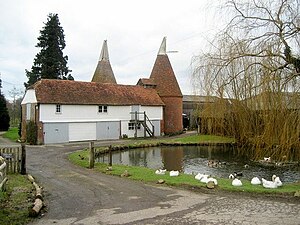Portal:Kent
Introduction

Kent is a county in the South East England region, the closest county to continental Europe. It borders Essex across the entire estuary of the River Thames to the north; the French department of Pas-de-Calais across the Strait of Dover to the south-east; East Sussex to the south-west; Surrey to the west and Greater London to the north-west. The county town is Maidstone.
It is the fifth most populous county in England, the most populous non-metropolitan county and the most populous of the Home Counties, an area influenced by the capital such as commutes and transport connections to the capital. Twenty-eight per cent of the county forms part of two Areas of Outstanding Natural Beauty: the North Downs and The High Weald. (Full article...)
Selected article

An oast, oast house or hop kiln is a building designed for kilning (drying) hops as part of the brewing process. They can be found in most hop-growing (and former hop-growing) areas and are often good examples of vernacular architecture. Many redundant oasts have been converted into houses. The names oast and oast house are used interchangeably in Kent and Sussex. In Surrey, Hampshire, Herefordshire and Worcestershire they are called hop kilns.
They consist of a rectangular one- or two-storey building (the "stowage") and one or more kilns in which the hops were spread out to be dried by hot air rising from a wood or charcoal fire below. The drying floors were thin and perforated to permit the heat to pass through and escape through a cowl in the roof which turned with the wind. The freshly picked hops from the fields were raked in to dry and then raked out to cool before being bagged up and sent to the brewery. The Kentish dialect word kell was sometimes used for kilns ("The oast has three kells") and sometimes to mean the oast itself ("Take this lunchbox to your father, he's working in the kell"). The word oast itself also means "kiln".
The earliest surviving oast house is at Golford, Cranbrook near Tunbridge Wells. It dates from sometime in the 17th century and closely mirrors the first documentary evidence on oasts soon after the introduction of hops into England in the mid-16th century. Early oast houses were simply adapted barns, but, by the 18th century, the distinctive tall buildings with conical roofs had been developed to increase the draught. At first, these were square, but around 1800 roundel kilns were developed in the belief that they were more efficient. Square kilns remained more popular in Herefordshire and Worcestershire and came back into fashion in the southeast in the later 19th century. In the 1930s, the cowls were replaced by louvred openings as electric fans and diesel oil ovens were employed.
Hops are today dried industrially and the many oast houses on farms have now been converted into dwellings. One of the best-preserved oast house complexes is at the Hop Farm Country Park at Beltring. (Full article...)
Selected images
Selected biography
William Roger Dean (born 31 August 1944) is an English artist, designer, and publisher. He began painting posters and album covers for musicians in the late 1960s. The groups for whom he did the most art are the English rock bands Yes and Asia.
The covers often feature exotic fantasy landscapes. His work has sold more than 150 million copies worldwide. (Full article...)
Things you can do
Nominate:

Join the WikiProject Kent: Any help on the Kent project would be gratefully received, even if only on your local area of expertise. FAQ about editing Ask the project a question here

Tasks: Here are some Kent related tasks you can do:
- Clean up an article: Here are automatically generated lists of articles needing cleanup sorted alphabetically and by category.
- Edit the Top and High importance articles.
- Refine/polish: Ashford, Royal Tunbridge Wells, Canterbury
- Expand:: List of churches in Kent, Maidstone Borough Council
- NPOV: K College
- Citation needed: Unreferenced Kent articles
- Cleanup/Copyedit: Kingdom of Kent
- Expert attention: Channel Tunnel, Bromley Civic Society
- Stubs: see Kent geography stubs articles
Note: These articles may overlap with those on other related lists. If you would like to make a change, either do so yourself, or make a suggestion.
Districts in Kent
Kent is divided into 12 local authority districts and Medway Unitary Authority.
Did you know...

- ... that the present town of Ashford in Kent, England, originates from an original settlement established in 893 AD by inhabitants escaping a Danish Viking raid?
- ...that Charles Davis Lucas, the first person to be awarded the Victoria Cross, is buried in the churchyard of St Lawrence's Church in Mereworth, Kent?
- ...that the village of Chiddingstone near Sevenoaks is unique in that with the exception of church and castle it is entirely owned by the National Trust?
- ...that Matthew Webb, the very first person to swim the English Channel, left from Dover in 1875 ?
- ... that the world’s first aircraft factory was opened at Eastchurch on the Isle of Sheppey by the Short Brothers in 1909?
- ... that there were 36 Kings of Kent?
- ... that Herne Bay Pier was the setting for the opening sequence of Ken Russell's first feature film French Dressing?"
On this Day - May 22nd
- 1934 - Edward Temme became the first person to swim the English Channel in both directions.
- 1991 - The main Channel Tunnel rail tunnels met, constructed from England and France, on May 22, 1991 and on June 28, 1991, each accompanied by a breakthrough ceremony
The County
At the time of the 1831 census, Kent was the 10th largest county, covering 972,240 acres (3,934.5 km2), however by 1871 it had grown to 995,344 acres (4,028.01 km2) and became the 9th largest.
WikiProjects
Related portals
Associated Wikimedia
The following Wikimedia Foundation sister projects provide more on this subject:
-
Commons
Free media repository -
Wikibooks
Free textbooks and manuals -
Wikidata
Free knowledge base -
Wikinews
Free-content news -
Wikiquote
Collection of quotations -
Wikisource
Free-content library -
Wikiversity
Free learning tools -
Wikivoyage
Free travel guide -
Wiktionary
Dictionary and thesaurus












![Image 12 Credit: Michael Wilmore The Kent & East Sussex Railway was opened by Colonel H.F. Stephens, the railway engineer, in 1900. At its fullest extent, it ran nearly 22 miles[35km] from Robertsbridge on the Tonbridge to Hastings main line to Headcorn on the main line between Tonbridge and Ashford, Kent. More about the Kent & East Sussex Railway... (from Portal:Kent/Selected pictures)](http://upload.wikimedia.org/wikipedia/commons/thumb/2/2f/KentAndEastSussexRailway%28MichaelWilmore%29Oct2005.jpg/120px-KentAndEastSussexRailway%28MichaelWilmore%29Oct2005.jpg)
























